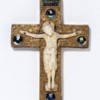Gold Reliquary Cross
Title
Gold Reliquary Cross
Subject
Archaeology
Description
2006BC6621_jpg_l and 2006BC6622_jpg_l. The cross is one of the rare surviving pieces which give substance to descriptions in contemporary documentary sources of the sumptuous church furnishings of pre-Conquest England. The enamels are unique in Anglo-Saxon art and may have been made by an English goldsmith familiar with German work. A fragmentary and not totally legible inscription around the edge of the cross seems to list the relics of saints once contained in the cavity beneath the ivory figure of Christ. This ivory figure was temporarily removed in 1926 for the purpose of being photographed and cast. Beneath it, lying in a hollow cut in the wood approximately 8.5 cm long, 2 cm wide and 1 cm deep was a dried human finger (perhaps a female index finger) pointing downwards with its outer surface to the front. Despite Papal disapproval of the dismemberment of saints, a finger relic was by no means unusual in Anglo-Saxon England: King Athelstan bestowed one third of his extensive collection of relics to the monastery of St. Mary and St. Peter at Exeter in AD 932. The gift included a finger, purportedly that of Mary Magdalene. All these images are © V&A Images/Victoria and Albert Museum,
London. These free low-resolution images are covered also under the museum's Terms and Conditions (http://collections.vam.ac.uk/information/information_termsandconditions). The full image collection is available at: http://www.vam.ac.uk and http://collections.vam.ac.uk/ where you can also order high resolution copies.
London. These free low-resolution images are covered also under the museum's Terms and Conditions (http://collections.vam.ac.uk/information/information_termsandconditions). The full image collection is available at: http://www.vam.ac.uk and http://collections.vam.ac.uk/ where you can also order high resolution copies.
Creator
Victoria and Albert Museum
Date
900-1000
Files
Citation
Victoria and Albert Museum, “Gold Reliquary Cross,” Woruldhord, accessed April 27, 2024, http://poppy.nsms.ox.ac.uk/woruldhord/items/show/416.


